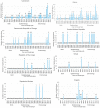Mosquito-Borne Arboviruses Occurrence and Distribution in the Last Three Decades in Central Africa: A Systematic Literature Review
- PMID: 38276174
- PMCID: PMC10819313
- DOI: 10.3390/microorganisms12010004
Mosquito-Borne Arboviruses Occurrence and Distribution in the Last Three Decades in Central Africa: A Systematic Literature Review
Abstract
Arboviruses represent a real public health problem globally and in the Central African subregion in particular, which represents a high-risk zone for the emergence and re-emergence of arbovirus outbreaks. Furthermore, an updated review on the current arbovirus burden and associated mosquito vectors is lacking for this region. To contribute to filling this knowledge gap, the current study was designed with the following objectives: (i) to systematically review data on the occurrence and distribution of arboviruses and mosquito fauna; and (ii) to identify potential spillover mosquito species in the Central African region in the last 30 years. A web search enabled the documentation of 2454 articles from different online databases. The preferred reporting items for systematic reviews and meta-analyses (PRISMA) and the quality of reporting of meta-analyses (QUORUM) steps for a systematic review enabled the selection of 164 articles that fulfilled our selection criteria. Of the six arboviruses (dengue virus (DENV), chikungunya virus (CHIKV), yellow fever virus (YFV), Zika virus (ZIKV), Rift Valley fever virus (RVFV), and West Nile virus (WNV)) of public health concern studied, the most frequently reported were chikungunya and dengue. The entomological records showed >248 species of mosquitoes regrouped under 15 genera, with Anopheles (n = 100 species), Culex (n = 56 species), and Aedes (n = 52 species) having high species diversity. Three genera were rarely represented, with only one species included, namely, Orthopodomyia, Lutzia, and Verrallina, but individuals of the genera Toxorhinchites and Finlayas were not identified at the species level. We found that two Aedes species (Ae. aegypti and Ae. albopictus) colonised the same microhabitat and were involved in major epidemics of the six medically important arboviruses, and other less-frequently identified mosquito genera consisted of competent species and were associated with outbreaks of medical and zoonotic arboviruses. The present study reveals a high species richness of competent mosquito vectors that could lead to the spillover of medically important arboviruses in the region. Although epidemiological studies were found, they were not regularly documented, and this also applies to vector competence and transmission studies. Future studies will consider unpublished information in dissertations and technical reports from different countries to allow their information to be more consistent. A regional project, entitled "Ecology of Arboviruses" (EcoVir), is underway in three countries (Gabon, Benin, and Cote d'Ivoire) to generate a more comprehensive epidemiological and entomological data on this topic.
Keywords: Central Africa; arboviruses; epidemics; mosquitoes; transmission.
Conflict of interest statement
The authors declare no conflict of interest.
Figures




References
-
- Willcox A.C., Matthew H., Collins M.H., Jadi R., Keeler C., Parr J.B., Mumba D., Kashamuka M., Tshefu A., de Silva A.M., et al. Seroepidemiology of Dengue, Zika, and Yellow Fever Viruses among Children in the Democratic Republic of the Congo. Am. J. Trop. Med. Hyg. 2018;99:756–763. doi: 10.4269/ajtmh.18-0156. - DOI - PMC - PubMed
-
- ECDC . Assessing the Yellow Fever Outbreak in Angola—European Medical Corps Mission Undertaken in the Framework of the European Union Civil Protection Mechanism. European Centre for Disease Prevention and Control, 10–20 May 2016. Volume 7 ECDC; Stockholm, Sweden: 2016.
-
- WHO Winning the War against Yellow Fever, Angola. 2016. [(accessed on 30 May 2023)]. Available online: https://www.who.int/news-room/feature-stories/detail/winning-the-war-aga....
Publication types
LinkOut - more resources
Full Text Sources
Miscellaneous

